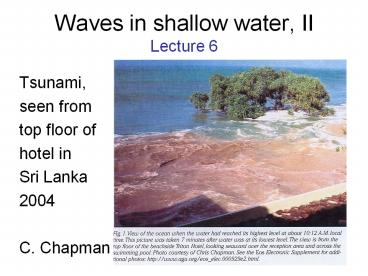Waves in shallow water, II Lecture 6 PowerPoint PPT Presentation
1 / 28
Title: Waves in shallow water, II Lecture 6
1
Waves in shallow water, IILecture 6
- Tsunami,
- seen from
- top floor of
- hotel in
- Sri Lanka
- 2004
- C. Chapman
2
Waves in shallow water, II
- Today (Lecture 6)
- Review derivation of KdV and KP
- Tsunami of 2004
- Kadomtsev-Petviashvili (KP) equation theory and
experiment - Shallow water equations
- (if time permits)
3
Review of theory for shallow water
- Governing equations (no surface tension)
- on z ?(x,y,t),
- -h lt z lt ?(x,y,t),
- on z -h.
4
Review of theory for shallow water
- 2. To derive KP (or KdV)
- Assume
- Small amplitude waves a ltlt h
- Shallow water (long waves) h ltlt Lx
- Nearly 1-D motion Lx ltlt Ly
- All small effects balance
- ? ltlt 1,
5
At leading order
- Wave equation in 1-D
- with
- ?
6
At leading order
- Wave equation in 1-D
- with
- ?
- At next order, satisfies either
- KdV
- or
- KP
7
A. Tsunami of Dec. 26, 2004
- Kenji Satake, Japan
- http//staff.aist.go.jp/kenji.satake/
- or, see
- Steven Ward, US
- http//www.es.ucsc.edu/ward
8
Tsunami of 2004
- Approximate
- Length scales
- Indian Ocean
- h 3.5 km
9
Tsunami of 2004
- Approximate
- Length scales
- Indian Ocean
- h 3.5 km
- For tsunami
- a 1-2 m
10
Tsunami of 2004
- Approximate
- Length scales
- Indian Ocean
- h 3.5 km
- For tsunami
- a 1-2 m
- Lx 100 km
11
Tsunami of 2004
- Approximate
- Length scales
- Indian Ocean
- h 3.5 km
- For tsunami
- a 1-2 m
- Lx 100 km
- Ly 1000 km
- c 650 km/hr
- (wave speed)
- u 200 m/hr
- (water speed)
12
Tsunami of 2004
- Kenji Satake, Japan
- http//staff.aist.go.jp/kenji.satake/
13
Tsunami of 2004
- Q Was the tsunami a soliton?
14
Tsunami of 2004
- Q Was the tsunami a soliton?
- A No
- KdV (or KP) dynamics occurs on a long time scale.
- For tsunami, typical horizontal length 100 km
- Distance across the Bay of Bengal 1500 km
- Too short for KdV dynamics to develop.
15
Tsunami of 2004
- Q Can a tsunami become a soliton?
- A Perhaps
- The largest earthquake ever recorded occurred off
Chile in May, 1960. - After 15 hours, it killed 61 people in Hawaii.
- After 22 hours, it killed 197 people in Japan.
16
Volume of water displaced(per width of shoreline)
1 m
100 km
17
Wave speed
- Open ocean
- c 650 km/hr
- A wave 100 km long passes by in about 9 minutes
- Near shore
- Front of wave slows as it approaches the shore
- Back of the wave is still in deep water
- Consequence Wave compresses horizontally and
grows vertically
18
The tsunami reaches land
- Statue of Thiruvalluvar (ancient Tamil poet)
- at southern tip of India - statue 133 ft tall
- (thanks to M. Lakshmanan www.bhoomikaindia.org)
19
Speculation on wave dynamics
- The first wave that
- hit Thailand was
- negative (wave of
- depression).
20
Simple, crude predictions(for tsunami warning
system)
- A tsunami can be generated by a thrust fault, a
normal fault or a landslide (all under water). - A strike-slip fault (by itself) will not generate
a tsunami. - A crucial quantity for estimating the size of a
tsunami is the volume of water displaced by the
underwater seismic event.
21
More simple predictions(for tsunami warning
system)
- The time required for the tsunami to propagate
from x1 to x2 along a fixed path is approximately
22
More simple predictions(for tsunami warning
system)
- The time required for the tsunami to propagate
from x1 to x2 along a fixed path is approximately - The detailed dynamics of a tsunami near shore
seem to be poorly understood.
23
Hurricane Katrina - Sept. 2006
- The damaging part of the hurricane was the storm
surge, which travels with speed - and carries mass
24
Other waves in shallow water
- Most ocean surface waves are caused by storms and
winds. - Travel thousands of kms, over several days
- Oscillate, approximately periodically
- Long waves travel faster than short waves
25
Other waves in shallow water
- Objective
- Find the natural structure(s) of oscillatory
ocean waves, including those - in shallow water
26
Oscillatory waves in shallow water
- Simplest model
- All waves travel with speed
- For long waves of moderate amplitude, all
traveling in approximately the same direction in
water of uniform depth, a better approximation
is - (Kadomtsev Petviashvili, 1970)
27
Oscillatory waves in shallow water
- Miracle The KP equation is completely
integrable. - It admits an infinite family of periodic or
quasi-periodic solutions of (?????). All of
these have the form - where ? is a Riemann theta function of genus g
- (g integer). The genus is the number of
independent phases in the solution.
28
References on quasiperiodic KP solutions
- Krichever (1976, 1977a,b, 1989)
- Dubrovin (1981)
- Bobenko Bordag (1989)
- Belokolos, Bobenko, Enolskii, Its Matveev
(1994) - Dubrovin,Flickinger Segur (1997)
- Deconinck Segur (1998)
- Feldman, Krörrer Trubowitz (2003)
- Deconinck, Heil, Bobenko, van Hoeij, Schmies
(2004) - http//www.amath.washington.edu/bernard/kp.html

